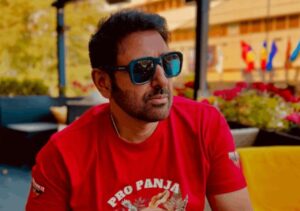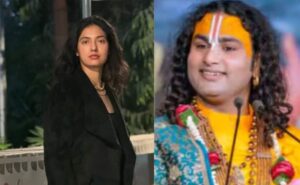
Most reality lifestyle shows are stuck with a necessary truth: None of these people would actually be friends, and many would never even know one another if they weren’t all cast on the same series together. On the Housewives series, there’s little defining cohesion to the group beyond “we live in the same region.” They walk into each other’s homes and are astonished by how bad the cheese/wine/décor/layout is. These are not women who know each other or belong together. But The Secret Lives of Mormon Wives, now in its second season, has built a very important innovation on the usual formula. It’s not that these women are all hanging out together for the sake of the show. They’re all hanging out together for the sake of #MomTok, their hashtag-bonded collection of TikTok content.
Except #MomTok is, well, nothing. Sure, there are videos, and there was the original swinging scandal that launched the whole series. There may have even been a period before the show began when #MomTok was a meaningful coalition of these people. But it’s not a business or a religion or even a poorly organized club. There is no governing body. There is no set of defined rules. There is no formal leader, or even official action to take to secure membership. Its name is so vague that it offers nary a hint of what it means or does for the Mormon wives, and TikTok is full of other totally unaffiliated women who use the hashtag to just mean being a mother. To the Mormon Wives cast, #MomTok is just an idea of a thing they’re all sort of doing together sometimes, yet it binds them to an imagined community they’re participating in, and a system of socially constructed self-identification that exists in alignment with, but not quite identical to, the reality show. (Benedict Anderson, I’m so, so sorry.) #MomTok is only as real as the Mormon wives pretend it is, and that’s why it makes for such stupidly good TV.
They are pretending #MomTok into existence very hard, of course. Their livelihoods and social lives and careful dance of adherence to and independence from Mormonism depend on it. To them, #MomTok is Mormon and yet paradoxically based on feminist empowerment. It’s rendered visible through matching athleisure, dance choreography, and who gets tagged in what videos. And, somehow, performing an allegiance (or at least relationship) with #MomTok is possible even when you’re doing it from outside of #MomTok. In October, after the first season of Mormon Wives appeared on Hulu, cast member Whitney Leavitt posted a video of a TikTok dance she and her colleagues (friends? fellow #MomTokers?) were choreographing while filming Mormon Wives. The text overlaid on the video itself is “welcome to the updated Mormon MomTok,” but Leavitt’s caption is “can you tell who really didn’t want to do this #mormonmomtok.” Does Leavitt’s jab suggest that one faction of the #MomTok allegiance is threatening to oust another? Does Leavitt simply want to leave? In January, her fellow cast member Mikayla Matthews posted a video with the onscreen caption “My friends told me we were meeting at 5, I showed up two hours early and saw this.” The video flips from front-facing video of Matthews’s face to the rear camera, of footage shot through a window or French door: other #MomTok members mid-video production, all in coordinating beige sweatsuits, arranging themselves in front of a ring light. Does this mean she’s no longer in #MomTok? Does performing your exclusion from #MomTok functionally reassert your #MomTok membership just by association?
The ridiculous self-policing performance of being in #MomTok is not that far a leap from other kinds of performative demonstrations of group belonging, things like sorority hazing or the aesthetic strictures of tradwifery (or, you know, Mormonism). But equally in the other direction, it’s not a far leap to There’s Absolutely No Other Reason These Women Hang Out Together. They don’t use the hashtag in the same ways: Taylor Frankie Paul adds it to videos of herself cleaning up her house, and Matthews adds it to footage of her toddler falling asleep in a funny place. Jessi Ngatikaura and Layla Taylor use it mostly on sponsored posts. Jen Affleck disappeared from TikTok for several months after the first season of Mormon Wives and returned with a pregnancy announcement (not labeled #MomTok) and now is just as likely to tag the Hulu show’s official account as she is to use the #MomTok hashtag — despite being a founding! member! It’s chaos! For some of the women, #MomTok is part of a seemingly sincere performance of motherhood. For others, it seems like a chore or a sponsored label that brands can get if they pay for it. Sometimes it’s a group activity; sometimes it looks very lonely. It’s not anything really, not in any consistent way.
All of which is why the best thing about The Secret Lives of Mormon Wives is anytime one of these women looks into the camera and says, “I’m just trying to protect #MomTok.” This happens constantly throughout the show — the trailer for season two is a litany of #MomTok complaints and concerns — but the thing is … no you’re not! None of you actually care about #MomTok! It has become a meaningful source of revenue through brand sponsorships, yes, but whatever thin ideology might once have been associated with the glorified group project has been completely emptied out. Now it’s just a thing people can say, a shared code of belonging that no one really believes in anyhow except for, suddenly, when they care very, very much.
They care because the imaginary community of #MomTok lets the Mormon Wives cast talk endlessly about being on The Secret Lives of Mormon Wives without breaking the central rule of being on a lifestyle reality show, which is that you can’t talk too much about being on a reality show. Cast members can go on vacations they would never otherwise go on, but they can’t say, “We’re on this vacation designed to create set pieces for this show.” They can host parties for the show, but they can’t say, “We’d never invite this person because we hate them, except obviously that is our job on this show.” But the Mormon wives can look straight into the camera and say, “#MomTok is turning on each other left and right,” when what they mean is, “The cast of this show is fighting.” They can also say, “Anyone that comes in at this point is clout chasing,” and the text of it is #MomTok, but it’s really that someone new has been added to the cast. #MomTok can be code for “we’re all putting on this performance of social affinity together,” and it does not matter in the slightest whether that’s about filming TikToks or filming the series. Talking endlessly about #MomTok lets Mormon Wives include a delicious layer of meta discussion that most other series have to siphon off into social-media feuds and reunion-episode battles.
The last and perhaps most beautiful thing about #MomTok is that every time someone says the words out loud, they sound ridiculous and they make everyone listening also sound ridiculous. The words secret lives of Mormon wives are full of weight and drama and cultural expectations. Talking about feminism or gender roles or religion is instantly compelling. But #MomTok links everything about this show back to a fundamental and delightful superficiality. How can this be this serious? It’s about something called #MomTok! #MomTok. It’s so beautiful. It’s so inane. It’s so perfectly nothing at all.
That’s what makes The Secret Lives of Mormon Wives such compelling reality TV.

































































